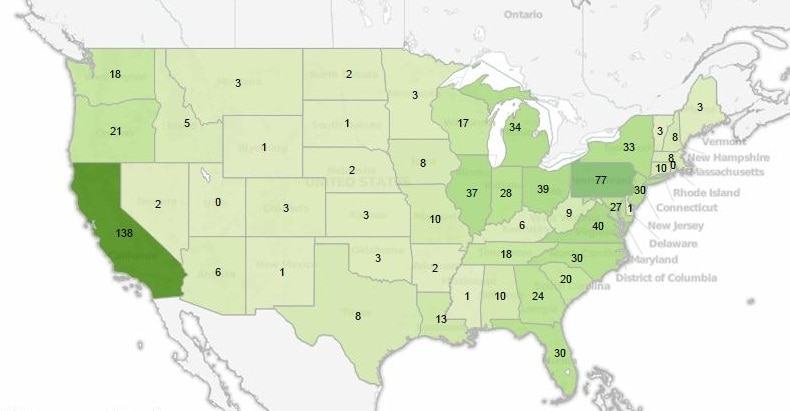
Banks Increasingly Move to Public Markets
 Three years after the financial crisis, we are finally seeing a resurgence of small banks around the nation raising capital, evident by the uptick in conversions, preferred stock and initial public offerings, as well as the number of private banks becoming publicly traded. Year-to-date, banks have raised $17 billion through preferred equity issuance, a pace that would surpass the $18.5 billion raised in all of 2012. Since January, 10 banks have joined the NASDAQ Stock Market: six as traditional IPOs, and four as transfers from the OTCQB marketplace.
Three years after the financial crisis, we are finally seeing a resurgence of small banks around the nation raising capital, evident by the uptick in conversions, preferred stock and initial public offerings, as well as the number of private banks becoming publicly traded. Year-to-date, banks have raised $17 billion through preferred equity issuance, a pace that would surpass the $18.5 billion raised in all of 2012. Since January, 10 banks have joined the NASDAQ Stock Market: six as traditional IPOs, and four as transfers from the OTCQB marketplace.
To better determine how banks are trading today, I turned to our OTCQB marketplace, where over 700 regional and community bank and thrift trade their securities, making OTCQB the best gauge for liquidity and trading activity in small community bank stocks. Twenty-four banks have started trading on OTCQB this year, 20 of them since June, an increase from 15 banks last year. Comparatively, NASDAQ has seen six IPOs this year, up from five in all of 2012.
One differentiating factor between the national stock exchanges and OTCQB is that to trade on OTCQB, companies do not have to file periodic reports with the Securities and Exchange Commission (SEC). Banks, already highly-regulated within their industry, often favor a path that minimizes additional regulatory requirements, which has led more than three-quarters of publicly-traded banks under $1 billion in assets to trade on OTCQB. A small company may spend $150,000 to $300,000 annually on maintaining a NASDAQ listing, with much of that expense allocated towards filings and attorney and accounting costs associated with SEC registration. As reported by the Independent Community Bankers of America, 90 percent of all U.S. banks have less than $1 billion in assets. This year, three banks have voluntarily left the NASDAQ Stock Market, taking advantage of a provision in the recently enacted Jumpstart Our Business Startups Act (the JOBS Act) that allows banks with fewer than 1,200 shareholders of record to deregister their stock.
The more than 700 banks and thrifts trading on OTCQB represent banking communities in almost every state, including 138 banks and thrifts in the state of California alone. The map below shows the geographic breakdown and the number of OTCQB-traded banks in each state.
Number of Banks or Thrifts Trading on the OTCQB by State

There are different reasons why banks choose to trade on OTCQB. Here are three of their stories.
Nicolet Bankshares (OTCQB: NCBS) – Nicolet Bankshares commenced trading on OTCQB in April 2013, following a merger with Mid-Wisconsin Financial Shares. Prior to 2005, Nicolet was an SEC-reporting company, but it made the decision to deregister when regulatory changes and compliance with the Sarbanes-Oxley Act proved too costly and complex for the small bank. Following its merger with Mid-Wisconsin, Nicolet is now the sixth largest bank holding company based in Wisconsin, with $1.1 billion in combined assets, achieving economies of scale to stay competitive and expand its market presence.
CU Bancorp (NASDAQ: CUNB) – CU Bancorp, a $1.2-billion asset bank, moved from OTCQB to NASDAQ in October of 2012. The bank, originally named California Republic Bank, opened in 2005 with a little more than $100 million in assets, following a $35-million private placement. Subsequently, the bank became publicly traded and remained a non-SEC filer up until its merger in 2012 with Premier Commercial Bancorp, another OTCQB bank. While trading on the OTCQB, CU Bancorp was successful growing organically and raising $67 million in capital. It also acquired two banks since 2011, eventually becoming large enough to qualify for a NASDAQ listing.
Standard Financial Corp (OTCQB: STND) – Standard Financial Corp., a $437-million asset bank operating in central Pennsylvania, went public on NASDAQ in 2010 following a mutual-to-stock conversion and offering. The bank traded approximately 7,000 shares a day on NASDAQ, which the bank determined was not sufficient trading volume to support the significant costs associated with a NASDAQ listing and SEC reporting requirements. As a result, Standard Financial recently deregistered with the SEC and began trading on OTCQB. According to Standard Financial’s board of directors, deregistration has allowed the company to “focus more on profitable operation of the company as opposed to the considerable time and effort necessary to manage compliance with SEC reporting requirements.” Standard Financial Corp. is the 12th bank to voluntarily delist from NASDAQ since the enactment of the JOBS Act.

